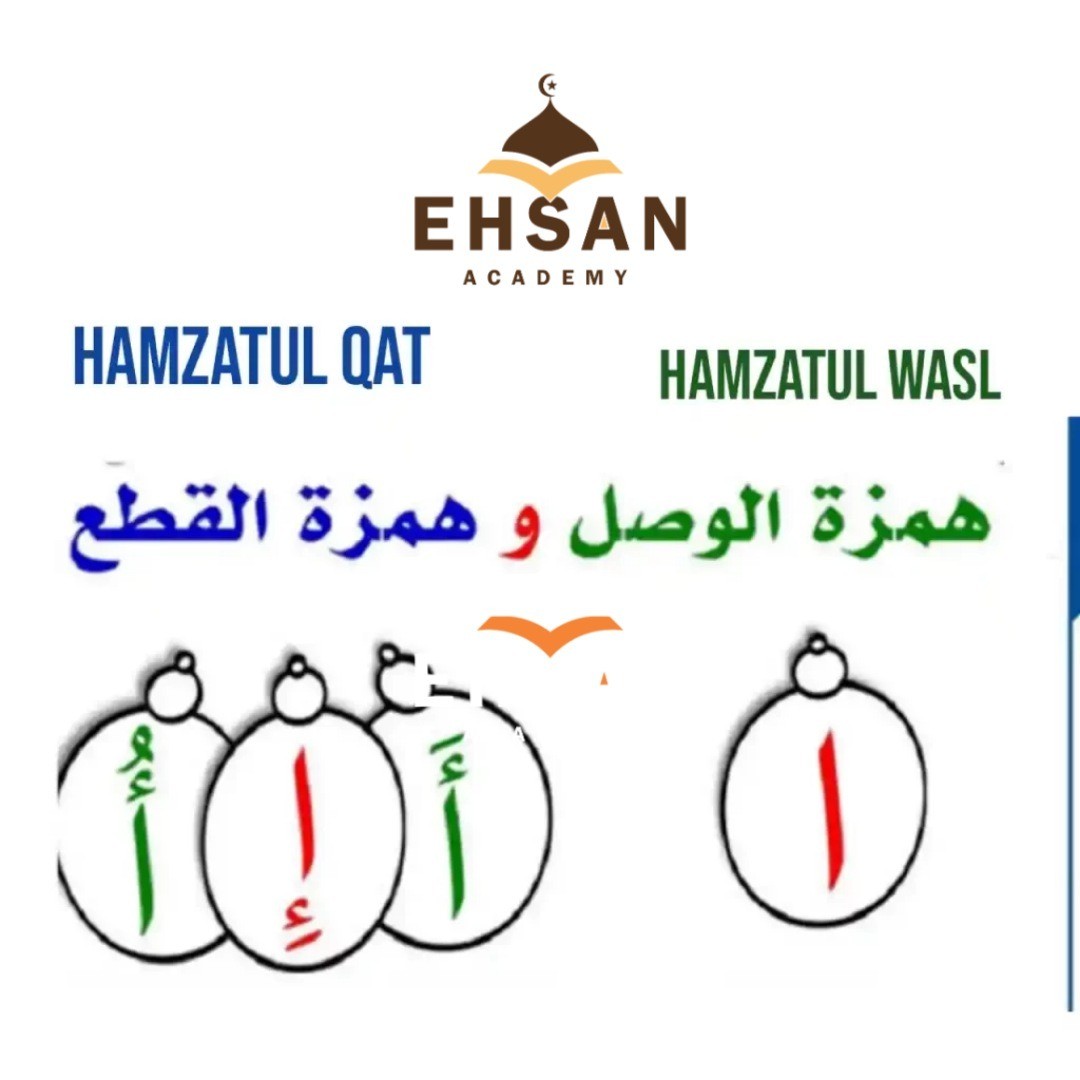Table of Contents
Understanding the Differences and How to Use Hamzatul Wasl and Hamzatul Qat Correctly and how they are important in tajweed rules of the Quran
Holy Quran is the superior book of the world. It’s not similar to the book of laws or any other book of the world which are merely used to drive the meaning, acknowledge and act upon its laws.
Holy Quran is most beloved to Allah and must be recited with love and respect. It is revealed to us so we can act upon its law, drive the meanings, learn and recite its astonishing poetic verses with perfect tajweed in the same easy as it thought by Prophet Muhammad (peace be upon him).
Arabic is a versatile language. Even a slighter change in the pronunciation of a word can entirely change its meaning. Therefore, it is highly important to attain the expertise in Quranic tajweed rules in order to learn Quran recitation.
Hamza (ء) is present in the Holy Quran in many forms and is regarded as one of the most important letters because it can affect the pronunciation and meaning of the Quranic word.
Hamzatul Qat and hamzatul Wasl are two types of hamza. They look similar but have unique characteristics and rules. Proper usage or pronunciation of hamzatul wasl and hamzatul qat is important to read the Holy Quran accurately. In this article, we will explore hamzat al wasl and hamzatul qat characteristics and rules for usage, and examples in the holy Quran.
Definition and rules of hamzatul wasl and hamzatul qat
What is Hamzatul Qat?
Hamzatul Qat is a non-connecting Hamza, which is represented by a small letter hamza (ء) placed above the first letter of the word. When a word initiates with a letter with sukoon or hamza, hamzatul Qat is pronounced as a glottal stop. In contrast to hamzatul wasl, hamzatul qat break, ceases, or halts the speech.
It is a cutting hamza that is represented by the symbol (ء). This letter has no resemblance to the Arabic letter alif ( ا ), but you can find it in different sections above and below the letter alif as ( أ or إ ). It can appear in the beginning, middle, or end of the word and is sounded in all cases.
Hamzatul Qat rules and example
- Hamzatul Qat appears in four forms: As it own form and With three vowels letter
- As its own form: بِئْسَ (Bi’sa)
- Alif: سَأَلَ (Sa’ala)
- Waaw: مُؤْمِنَة (Mu’minah)
- Yaa: بَرِيئْ (Baree’)
- It is always pronounced during recitation and speech
- It can be appeared on the top or beneath the alif
- It can appear on the top of alif, Waaw, and Yaa, For example, It is always pronounced irrespective of its location in the word
- Whenever hamzatul qat is found above harf madd, harf madd are is sounded.
- Hamzatul Qat is not pronounced similarly as an alif. The sound of hamzatul qat is created by cutting off the air stream at the top of the windpipe and instantly letting it go for a breath.
Hamzatul Qat examples in Quran
Hamzatul Qat is found in several places in the Holy Quran in the beginning, middle, and end of the sentence.
You can see through the below-mentioned verses how hamzatul qat appears at the beginning of the word.
ءَأَنتُمْ أَشَدُّ خَلْقًا أَمِ ٱلسَّمَآءُ ۚ بَنَىٰهَا ٢٧
Or
إِلَىٰ رَبِّكَ مُنتَهَىٰهَآ٤٤
In the middle of the word it may appear as:
يَسْـَٔلُونَكَ عَنِ ٱلسَّاعَةِ أَيَّانَ مُرْسَىٰهَا
And
فَإِنَّ ٱلْجَنَّةَ هِىَ ٱلْمَأْوَىٰ
At the end of the word, it may appear as:
وَٱلسَّمَآءِ وَمَا بَنَىٰهَا
Rules of tajweed when Hamzatul Wasl meets Hamzatul Qat
Whenever hamzatul wasl comes before hamzatul Qat, there are two different rulings of pronouncing it in Arabic grammar.
- Hamzatul Qat is pronounced: when hamzatul wasl comes as a constructive letter, dropped and not sounded, in this case, hamzatul qat is pronounced as per normal
Example,
فَإِنْ أَمِنَ بَعْضُكُم بَعْضًۭا فَلْيُؤَدِّ ٱلَّذِى ٱؤْتُمِنَ أَمَـٰنَتَهُۥ وَلْيَتَّقِ ٱللَّهَ رَبَّهُۥ ۗ وَلَا تَكْتُمُوا۟ ٱلشَّهَـٰدَةَ ۚ وَمَن يَكْتُمْهَا فَإِنَّهُۥٓ ءَاثِمٌۭ قَلْبُهُۥ ٢٨٣
Hamzatul Qat is not sounded here as the word is correctly read as:
الذِءْتُمِنَ
- Hamzatul Qat is silent: if the reciter is starting the recitation with hamzatul wasl at the beginning of the word, then hamzatul wasl is sounded and hamzatul qat is dropped.
Example
Here, hamza Qat has transferred into hamza wasl. The correct pronunciation of this word is:
أُوتُمِن.
Hamzatul Wasl in Arabic
In Quran, Hamzatul Wasl is pronounced like a regular vowel sound. It is identified when a word begins with an alif or vowel letter. Hamzatul wasl does not cease or break the sentence but is named as connecting hamza because it connects the word to the preceding word in recitation and speech.
Hamzatul Wasl shows its presence at the beginning of the word. It is used in different construction sentences, including the conjunction of some verbs, after the definite article, and in some pronouns.
Examples
| Hamzatul wasl as a connecting letter | Hamzatul wasl in the beginning of the word |
| رَبِّ ٱلْعَـٰلَمِينَ | ٱلْحَمْدُ لِلَّهِ |
| Correct: Rabil-‘aalameen Wrong: Rabi al-‘aalameen | Correct: Al-hamdu Wrong: Il-hamdu |
Hamzatul Wasl Rules and Example
- Hamzatul wasl is not similar to alif. It is written similarly to the letter alif (ا ). However, it can be easily distinguished from the letter alif, as it has a little saad (صـ) drawn on the top.
- It is clearly sounded when the reciter is beginning with the word that contains hamzatul wasl
- It is dropped if a vowel letter precedes it.
Hamzatul Wasl example in the Quran
In below mentioned verse, the word وَقُلِ الْحَمْدُ لِلّٰهِ (Wa qulil hamdu lillaahil) show its presence as a constructive letter. Here The hamzatul wasl is silent and not read and hence used to construct the sentence. This hamza is pronounced if it comes at the beginning of the word. For example, if you skip the Wa qulil and just want to read الْحَمْدُ لِلّٰهِ now the word will be recited as Alhamdu lillaahil
وَقُلِ ٱلْحَمْدُ لِلَّهِ ٱلَّذِى لَمْ يَتَّخِذْ وَلَدًۭا وَلَمْ يَكُن لَّهُۥ شَرِيكٌۭ فِى ٱلْمُلْكِ وَلَمْ يَكُن لَّهُۥ وَلِىٌّۭ مِّنَ ٱلذُّلِّ ۖ وَكَبِّرْهُ تَكْبِيرًۢا ١١١
The difference between hamzatul wasl and Qat
Hamzatul wasl and hamzatul Qat are not similar to each other. Both the hamzas of Arabic have different rules and characteristics. Following are some major differences between hamzatul Wasl and hamzatul Qat.
- Hamzatul wasl is a connecting letter whereas hamzatul qat is a cutting letter.
- Hamzatul Qat is pronounced at the beginning, middle, or end of the word, whereas hamzatul wasl is only sounded at the beginning of the word.
- Hamzatul Qat can appear in different forms, whereas hamzatul wasl only appears in one form.
- Hamzatul wasl doesn’t appear with haraka, whereas hamzatul qat can have haraka and sukoon.
Importance of Hamzatul wasl
The importance of rule of Hamzatul Wasl is that it is only used when the two words are in the same sentence or clause. If the two words are in separate sentences or clauses, then the glottal stop is not used.
The application of Hamzatul Wasl can significantly impact the meaning of a sentence. For example, the word “Al-Kitab” means “the book,” and the word “Kitab” means “book.” The glottal stop in “Al-Kitab” is used because the word is preceded by the definite article “Al,” which ends with a vowel. If the glottal stop were not used, the meaning of the sentence would change from “the book” to just “book.”
Hamzatul Wasl is also used to facilitate proper Quranic recitation. It helps in the smooth flow of the recitation and ensures that the words are pronounced correctly. The glottal stop is used to connect words that would otherwise be pronounced separately, which can be jarring to the listener and disrupt the flow of the recitation.
Hamzatul Wasl is also important for the preservation of the Quran. The glottal stop is used to connect words in the Quran, and its correct application ensures that the words are recited as they were revealed to the Prophet Muhammad (PBUH). The Quran is memorized and recited by millions of Muslims worldwide, and the correct application of Hamzatul Wasl is essential for the preservation of the Quran’s original text.
In conclusion, Hamzatul Wasl is a unique feature of the Arabic language that plays a significant role in Quranic recitation. It is a glottal stop that occurs at the beginning of certain words when they are preceded by a certain grammatical construction. The correct application of Hamzatul Wasl is essential for proper Quranic recitation and comprehension. It helps in the smooth flow of the recitation, ensures that the words are pronounced correctly, and is important for the preservation of the Quran’s original text.
Learn Quran with tajweed
It is the due duty of every Muslim to learn the recitation of the holy Quran with tajweed. Quran contains beautiful verses that should be recited correctly in the same way it was revealed and recited by Prophet Muhammad (peace be upon him). In order to read the Holy Quran perfectly with a beautiful accent, you will need to get yourself enrolled in Ehsan Academy.
Ehsan Academy offers 1-on-1 classes in the comfort of your own house. Ehsan Academy is the best choice for beginners who wants to master recitation and have no previous knowledge. Our experienced team of teachers makes customized study plans for you that help you learn Quran with Tajweed without any difficulty.
What’s more?
We are 24/7 available for you. Enrol now with us and start your beautiful journey of learning the Quran online with tajweed!
Learn more about Hamzatul Wasl and Hamzatul Qat from Here
FAQs
Hamzatul Wasl pdf and Hamzatul Wasl worksheet
Hamzatul wasl pdf guide and hamzatul wasl worksheet can help you learn and practice the rules. You can find the hamzatul wasl pdf guide from the link given below.
Hamzatul-wasl.pdf and Hamaul Wasl Worksheet
How many pages in Quran
There are 604 pages in the Holy Quran.which means you can complete the entire Quran in 30 days by reciting 4 pages after each prayer.
How to learn Tajweed Quran/ Quran with tajweed?
You can learn tajweed Quran or Quran with tajweed with the help of tutors that have expertise in recitation of the Holy Quran. No matter how many guidebooks of tajweed you exercise at your home. A good tajweed teacher can not be replaced bythose guidebooks. Ehsan academy provides you expert teachers at the comfort of your own house and that too, within affordable and free classes.
Where to find Online Quran classes in the USA
Ehsan academy is an online academy that offers a wide range of online Quran classes for USA and for all the Muslims living in Muslins and non Muslims countries. Ehsan academy have a best team of the world that are certified from world renowned universities to teach the holy Quran recitation, Holy Quran with tajweed, Arabic language and Islamic studies.
What are the rules of reading the Quran?
Holy Quran is the divine book of the world that must be recited with complete tajweed. There are various versatile rules of reading the Quran. Ehasan Academy also offers tajweed for beginners to help every Muslim master the recitation of the Holy Quran.
What is the reward of applying tahweed rules?
The reward of applying Tajweed rules in the recitation of the Quran is considered to be great in Islam. Here are some of the rewards mentioned in Islamic teachings:
Blessings and Rewards from Allah: Tajweed is considered a form of worship and reciting the Quran with proper Tajweed is believed to bring blessings and rewards from Allah. This reward is considered to be both in this life and in the hereafter.
Increased Understanding and Appreciation of the Quran: Tajweed helps to enhance the understanding and appreciation of the Quranic text by ensuring that it is recited in a clear and understandable manner. By applying Tajweed rules, reciters can convey the correct meaning of the Quranic text and deepen their understanding of the Quran.
Calming Effect on the Listener: The melodious recitation of the Quran can have a calming effect on the listener and can help to soothe the mind and heart. This can be particularly helpful for those experiencing stress, anxiety, or other emotional challenges.
Protection from Shaytan: Reciting the Quran with proper Tajweed is believed to protect the reciter from the whispers of Shaytan (Satan) and evil thoughts. This protection is considered to be both physical and spiritual.
Increased Spiritual Connection to Allah: Tajweed is an important aspect of reciting the Quran and helps to deepen the spiritual connection to Allah. By reciting the Quran with proper Tajweed, Muslims can strengthen their faith and relationship with Allah.







